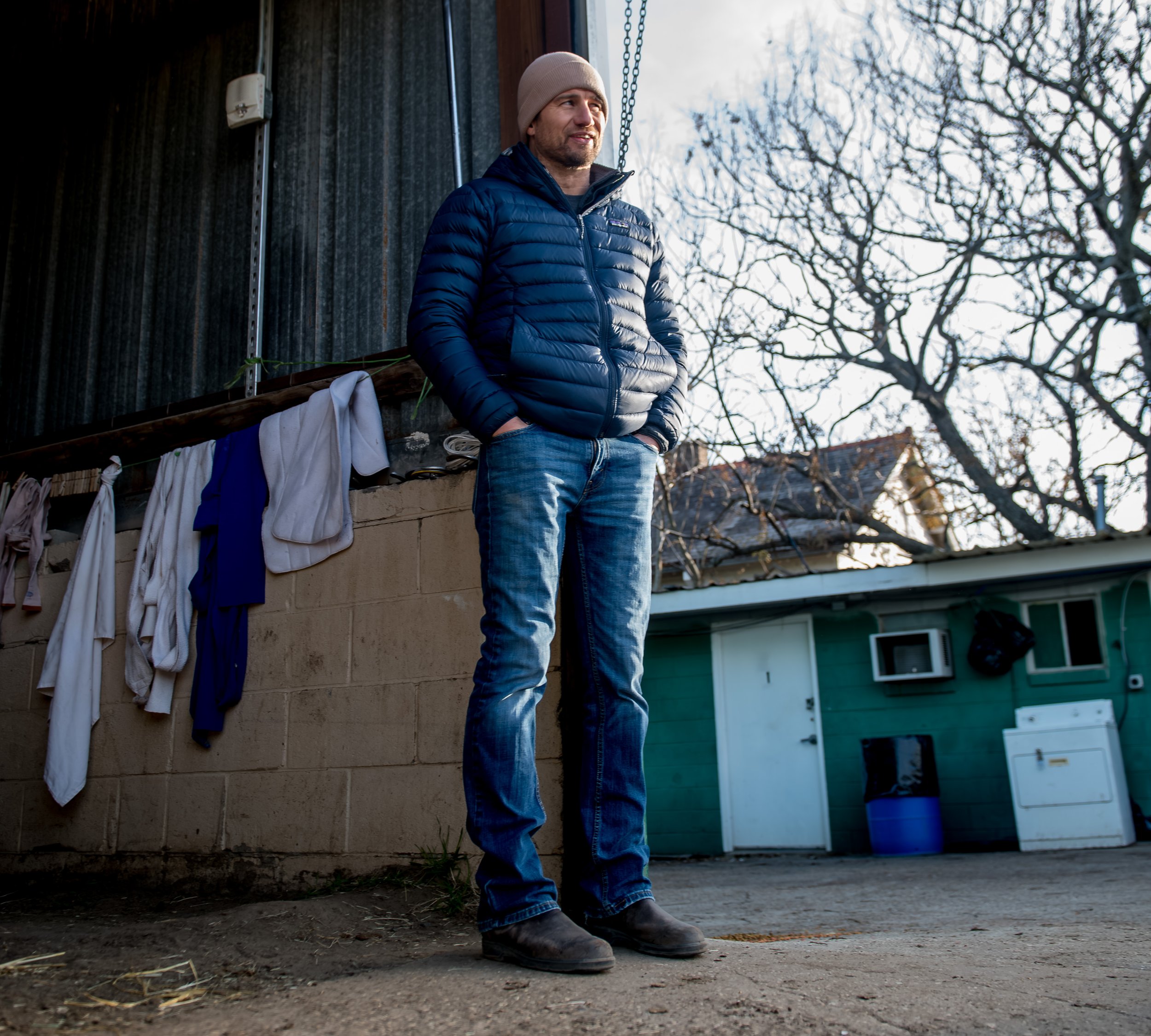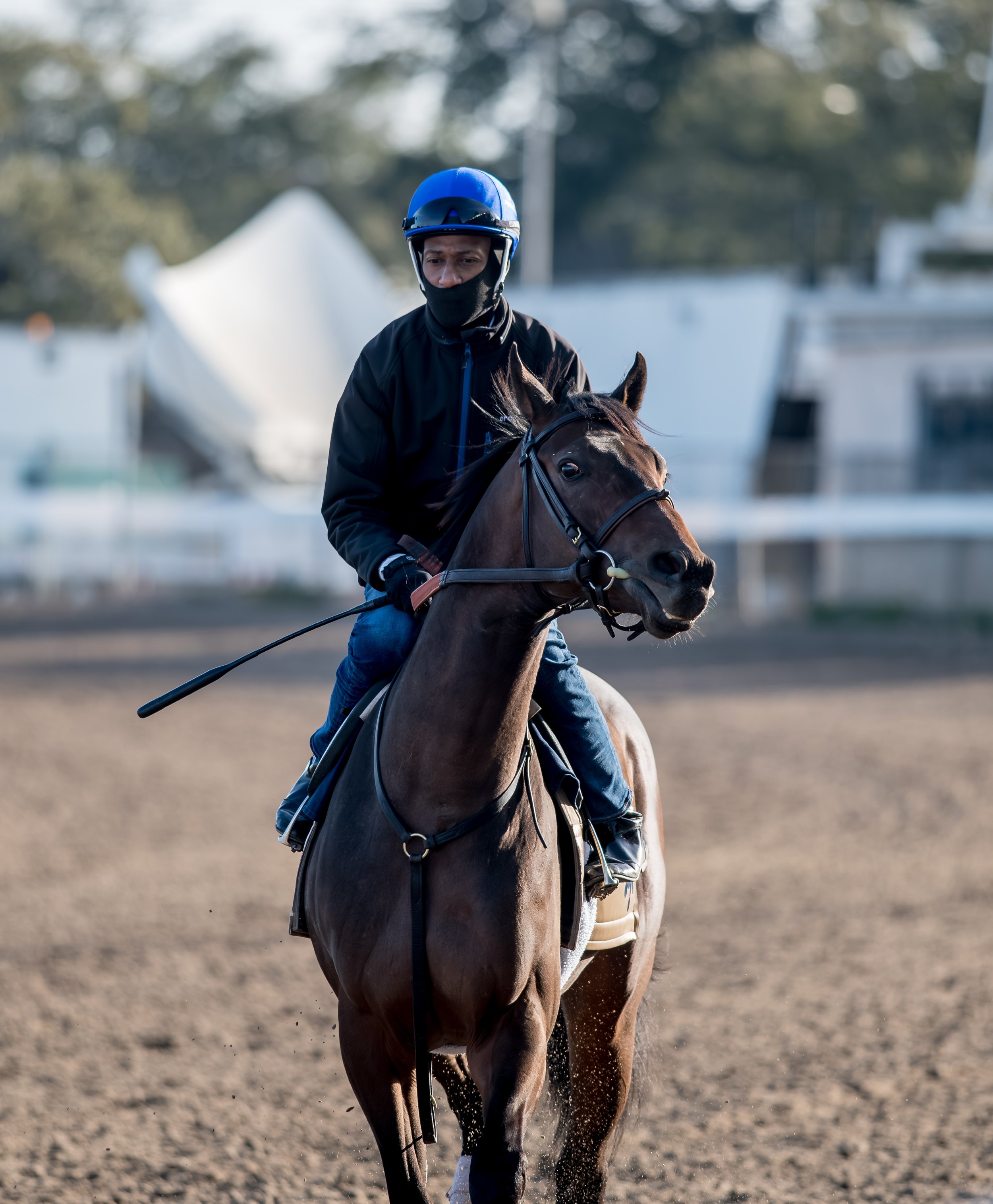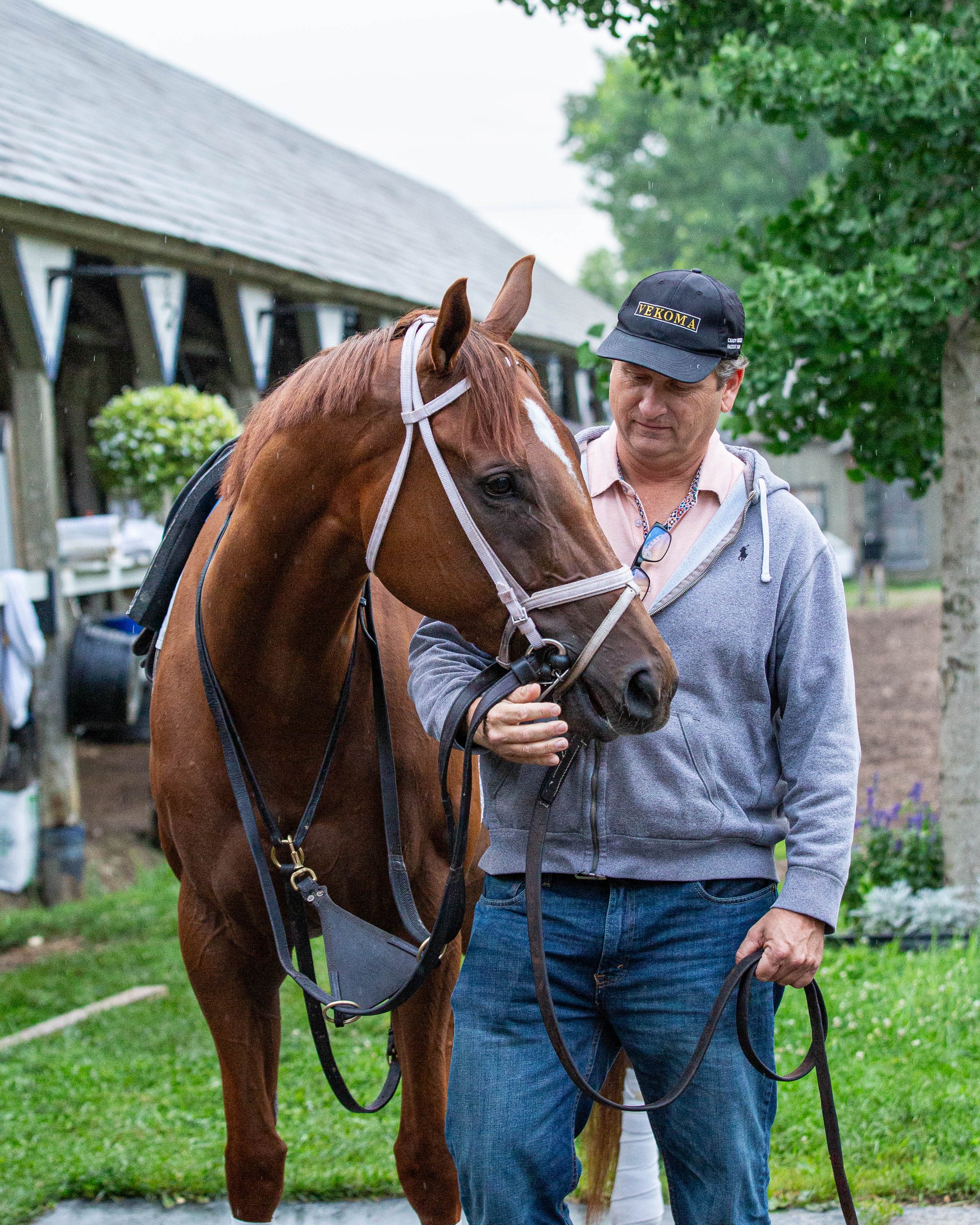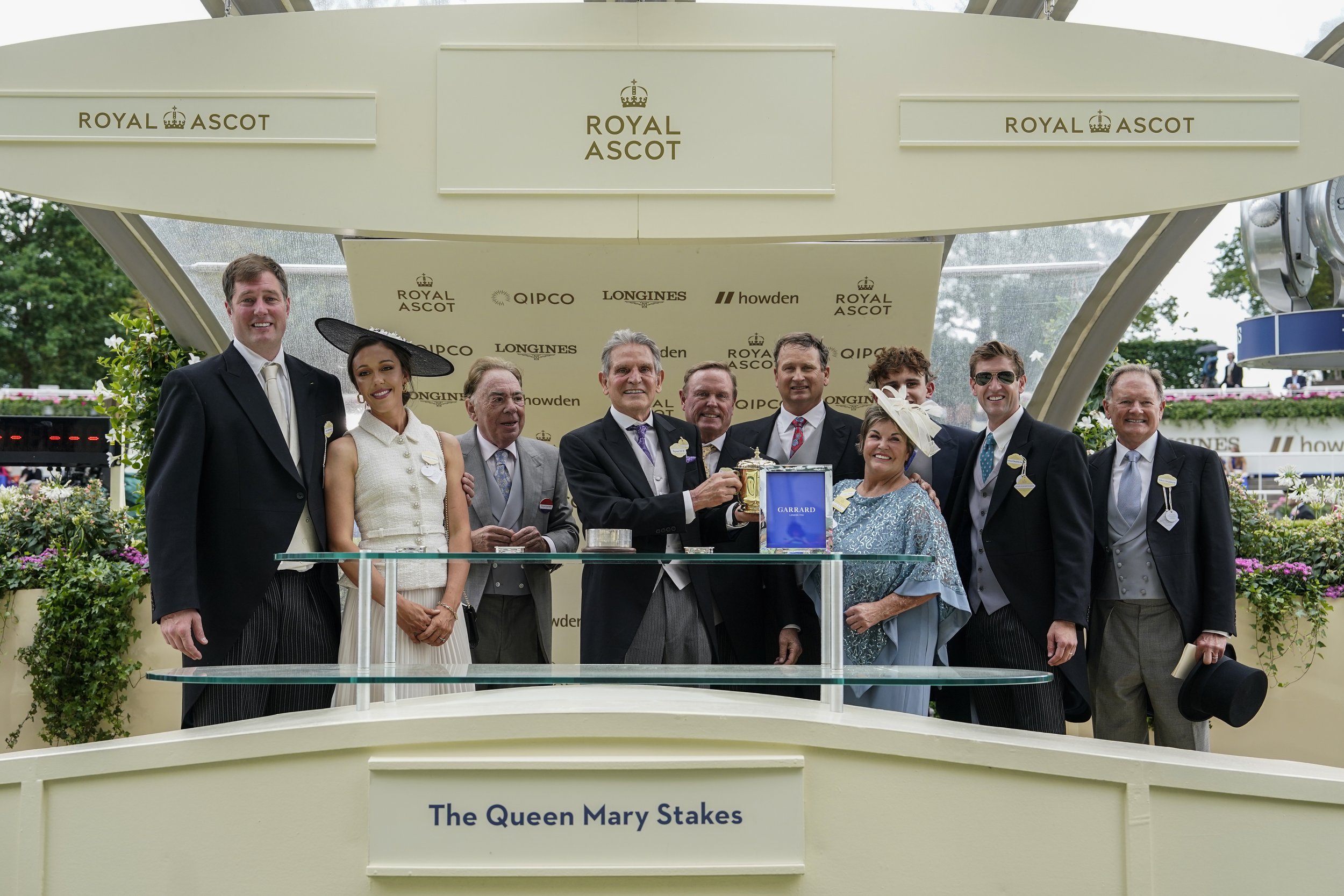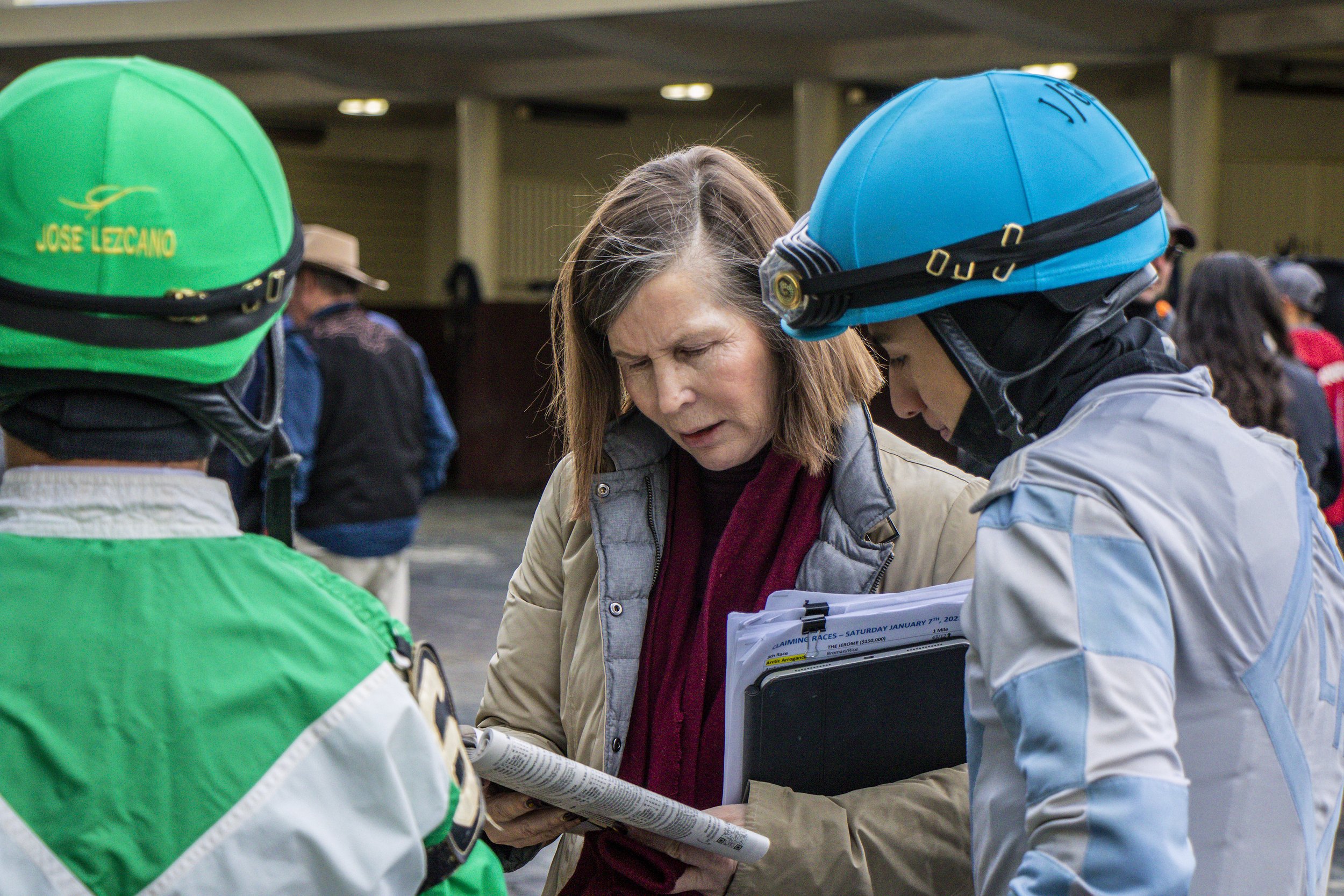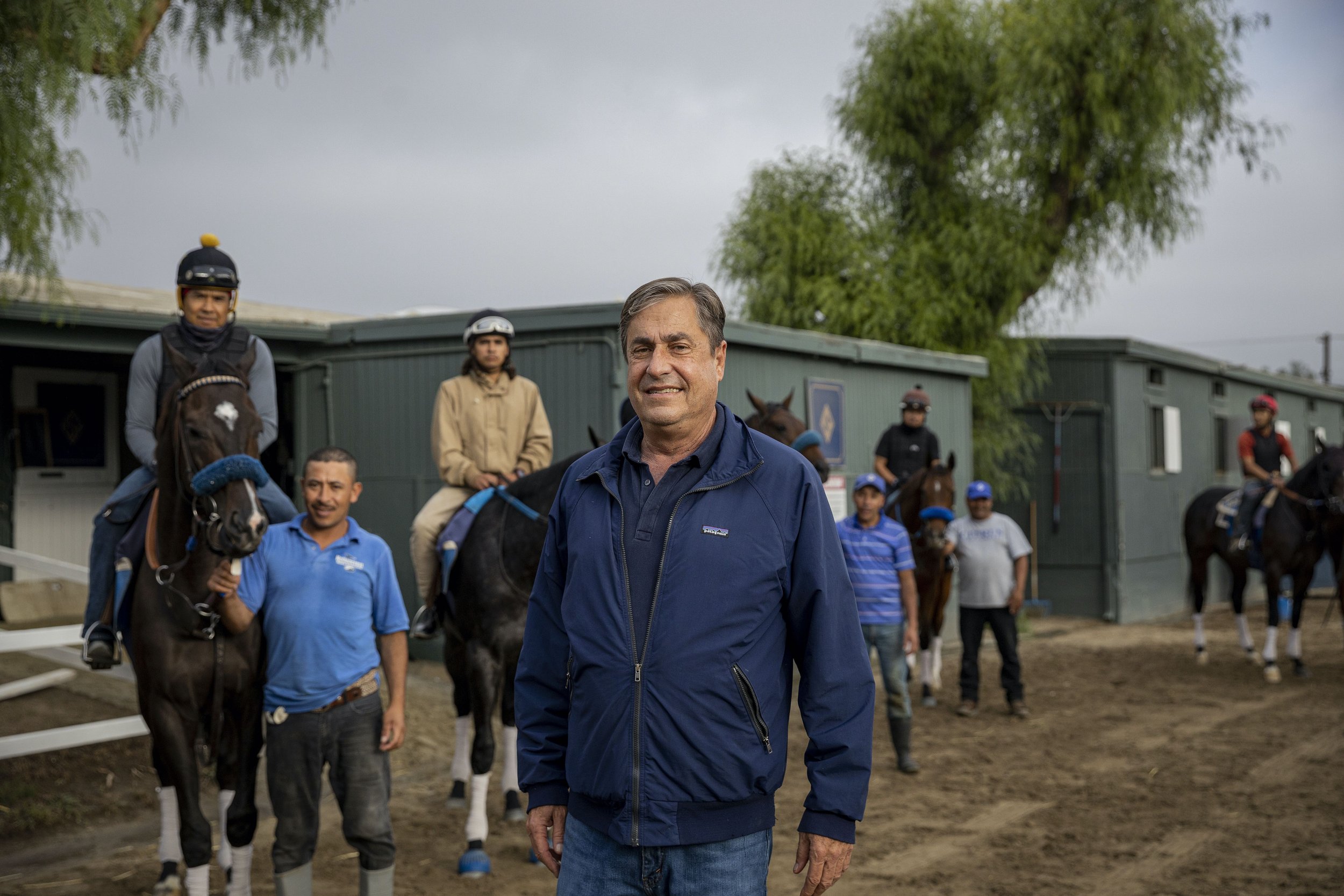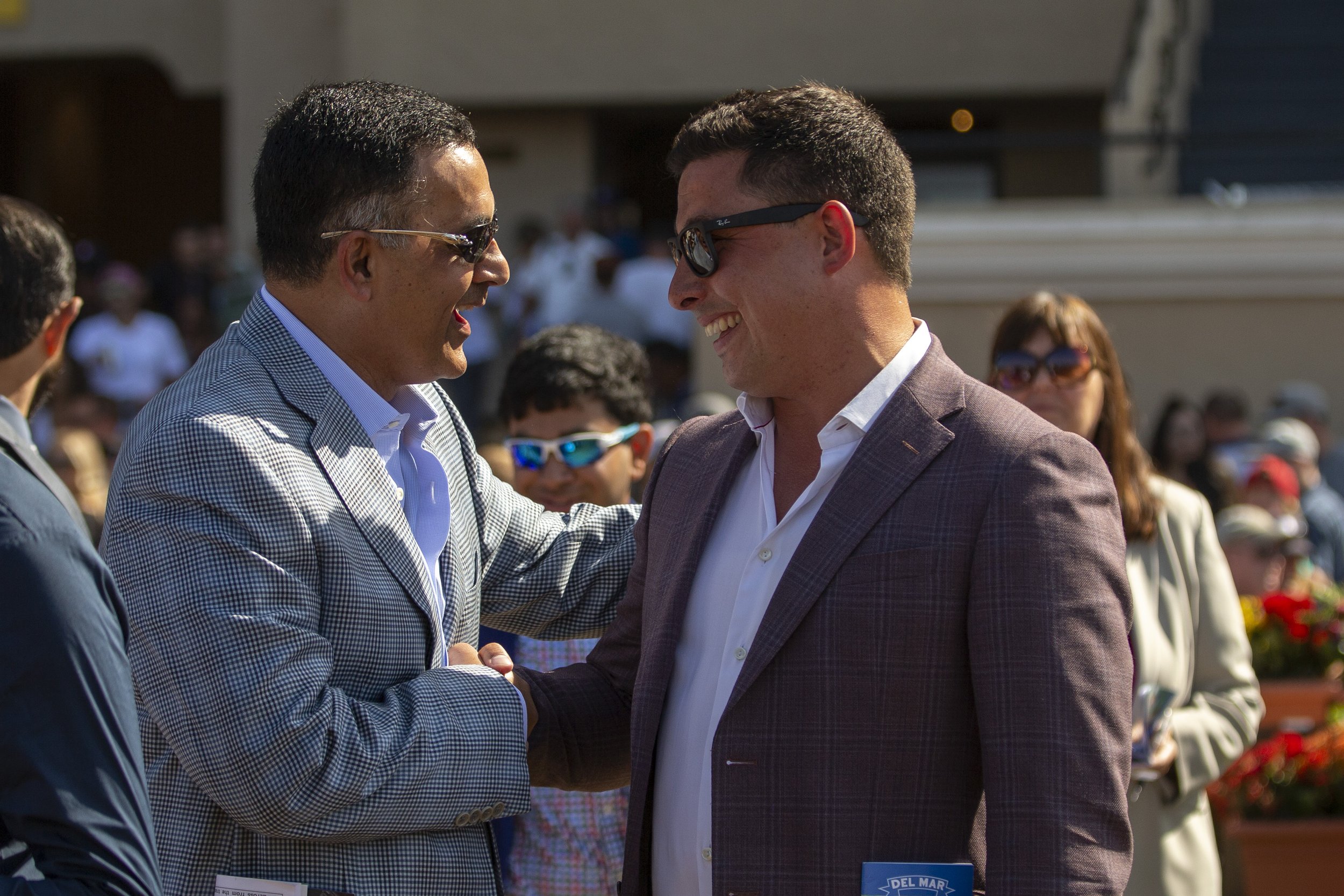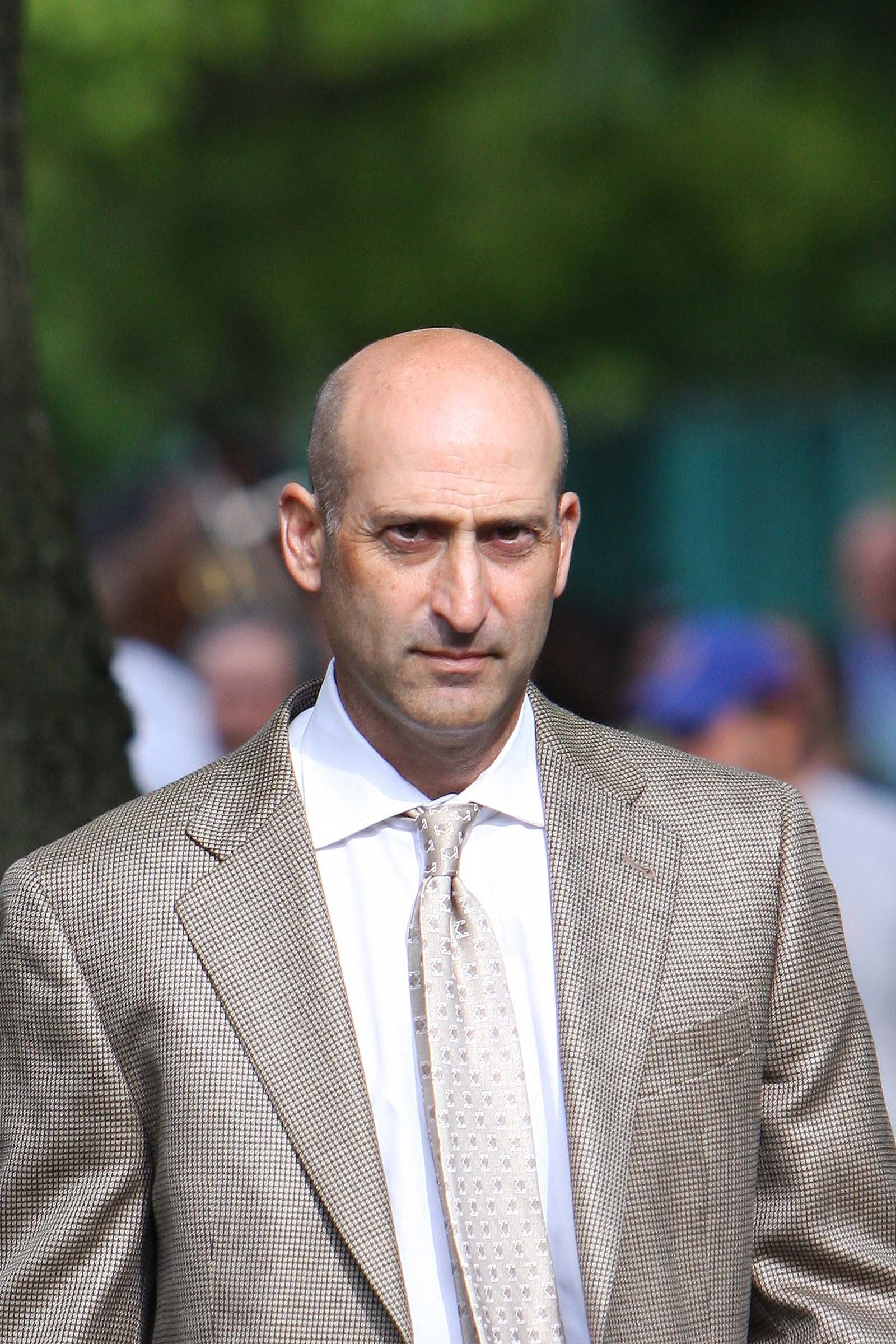Whit Beckman trainer of Belmont Stakes contender - Honor Marie
Article by Bill Heller
Trainer D. Whitworth Beckman grew up around horses but had never made the connection his parents did. His father, David, is a vet. His mother, Diane, rides and shows horses. “I was around them, but I wasn’t really interested, horses weren’t even on my radar.”
He spent two semesters at the College of Charleston. “I partied a lot,” he said. “I didn’t have any purpose. I was aimlessly floating around on alcohol. After two semesters, I figured I was wasting my time and wasting my parents’ money.”
His life got worse after dropping out from college. “I got pretty heavily involved with drinking. I hung out with a crew. A little wild. There was nothing that gave me purpose. I was a selfish kid.”
Eventually, he began helping his mom take care of polo horses and old show horses. And then he met his mom’s most difficult horse, a cantankerous Thoroughbred named Black Pearl. “I still have him,” his mother said. “We call him Blackie. He was a kook. He couldn’t be trained. He took off with his rider every morning, constantly switching leads. Whit taught himself how to ride on that horse.”
She still can’t believe it.
Beckman had found his purpose. “What I found with this horse was a new connection,“ he said. “He taught me a lot. You can lie and cheat with people. With a horse, it’s 100 percent honest. They do all the crap we ask them to do. They don’t lie or cheat. I think that’s refreshing. We should learn from them.”
He still is, and he doesn’t preclude learning from people, too. He worked for Todd Pletcher, Eion Harty and Chad Brown. Sandwiched in between, he trained in Saudi Arabia.
In 2023, only Beckman’s second full year on his own in the United States, he posted 13 victories, 13 seconds and four thirds in 102 starts with $1,468,695 in earnings, more than double what he earned the previous year. He recorded his first stakes victory and, soon afterwards, his first graded stakes. His stable grew from one horse to 26.
He had help, especially from his best friend Kristian Villante, a bloodstock agent who trades under the name of Legion Bloodstock. They became friends when they both worked for Todd Pletcher. “We have very similar personalities,” Villante said. “We became friends and it kind of grew.”
Villante helped Beckman grow his stable. “We said we’d give him the push,” Villante said. “You can open the door for someone, but then, it’s up to him what to do with it. You can provide the opportunity. A lot of credit to Whit.”
It’s been a journey. His mother said, “He doesn’t give up and he always shows up.”
“He didn’t get lucky,” Harty said. “He conducts himself in an exemplary fashion. He’s a good communicator. He’s a very good person. He inherited it from his family. I got to meet them a couple times. You can tell where he got it from.”
But his family didn’t see it coming.
“If you would have told me when he was in high school that he’d get up at 4:30 in the morning to take care of horses, I’d say you’re crazy,” recounted his father, David. “He’d go to a variety of farms with me and he didn’t seem to like it at all.”
His parents sure did. David and Diane Beckman met in a barn. “I was just out of college and I ran a barn in Goshen,” Diane said. “David came to the barn one day. He’s like Whit, very quiet. I thought he was very good-looking.”
David, who had just graduated from veterinary school in 1979, asked her to a University of Kentucky football game. They both went there.
Diane was smitten: “After a couple of months I said, `I want to marry him.’ His character … we’ve been married 42 years and I’ve never known anyone I respect more. He’s been a great father. He works every day. He’s kind. He was on call 24/7.”
The Beckman’s have four children. Whit is the oldest. “When the two boys would get in trouble and David wasn’t there, I’d say, `You’re going to go with your dad and work on weekends.’ I think that’s what turned Whit off on horses – for a while.”
Beckman explained, “She’d say you’re going to work with him. I associated being bad with horses.”
Whit seemed isolated growing up. “He struggled,” his mother said. “He was so shy. He was a kid who lived in his imagination. We sent him to college when he wasn’t ready for it. The College of Charleston put him in a hotel because the dorms were full. It wasn’t a good fit. He came home, and at that point he was really lost. He didn’t have the straight path in life. He met his struggles and has worked through them. Whit was a late bloomer.
“I have always been proud of the person Whit is. He’s trustworthy, and he’s always going to do the right thing, like his father. He’s never going to say anything unless he means it. He’s going to be honest. I’ve always been proud of him because he had the roughest road. He willed himself to where he is today.”
It took a decade and a half and many, many miles. After working with his mother’s horses, Beckman began working with Walter Binder at Churchill Downs and Louisiana Downs. Beckman returned to Kentucky in March, 2006, and his father helped him get a job with Alex Rankin at Up and Down Farm. “It was a great place to learn,” Beckman said. “It gave me a lot of experience. I developed horsemanship.”
He continued to develop that working with Dave Scanlon and Danny Montada getting Darley two-year-olds ready for sale at Keeneland.
Beckman was fortunate to meet trainer Eoin Harty, who reached out to Todd Pletcher for him. Later, Harty would hire Beckman to be his assistant.
Beckman began working for Pletcher at the 2007 Saratoga meeting. “Towards the end of the meet,” Beckman said. “You go to Kentucky. You see the routine. At that time, I could just wake up every morning and say, `How cool is this? I’m working for the top trainer in the country.’”
Pletcher was glad to have him: “He was always a very top-level assistant. Good horseman. Good demeanor around the barn. I’m not surprised to see him doing well.”
After working for Pletcher, Beckman journeyed to Saudi Arabia, an experience with mixed blessings. “At that point, I had just turned 30,” Beckman said. “It was an opportunity to go on my own. I thought it would be a cool thing to go to the Middle East. A rich tradition of horses. We won some races, but it was an extremely different environment. They bring you over, but they don’t listen. They say, `God’s will.’ Religion and their faith take precedence. It was sticky.”
In 2014, Beckman learned his girlfriend was pregnant. He returned to the U.S. and took a job with Harty. “He was already a qualified trainer by the time he got to me,” Harty said. “He was looking for a job and I was looking for an assistant. It worked out immediately. I showed him the way I like things to be done. He was a huge asset. He deserves nothing but the best.”
With a daughter on the way, Beckman returned to Saudi Arabia. He then returned to America to be there for her daughter Violette’s birth on December 23rd, 2015, three days after his 34th birthday. “When she was born, it was the best thing in my life,” he said.
Yet he was ready to return to Saudi Arabia a few days later. “I got to the jetway,” Beckman said. “I was standing there. I couldn’t do it. I was thinking of myself. I wanted to be home with my daughter. I turned around. I felt great about it.”
He felt even better when Charlie Boden, then with Darley, told him Chad Brown was looking for an assistant, as if Beckman was being rewarded for staying with his daughter.
Beckman began working with Brown on April 4th, 2016, and stayed until the summer of 2021 when he ventured on his own with the full support of his sister, Lindley Turner, who had been doing their fathers’ bookkeeping since 2008. Now she does both. “When Whit decided to train on his own, I offered to handle all the financial and the bookwork,” she said. “Not fun stuff, but necessary to keep the business going. Whit was away for 20 years. I wanted to see what he spent 20 years doing. It’s really cool to watch.”
She really liked what she saw from her brother: “He did all aspects of the job. He put a lot of time in everywhere. He had a very clear vision of what he wanted his stable to look like. As a money person, I said, `I believe in your vision.’ We put in basically everything a top barn would. He knew how he wanted to take care of his horses. How his shed row would look. He did the digging. He raked it out himself. From the very start, he put in the system he knew. He told me if you do this now, it will pay off. He was exactly right. It’s come to life, even though we started with one horse.”
She vividly remembers when that first horse, Truly Mischief, an unraced two-year-old owned and bred by Newtown Anner Stud, arrived, September 11th, 2021: “I remember the horse coming to me, and feeling bad for him because he was the only horse in the barn. I said, `We’re going to get you some buddies.’ It was really exciting, just watching Whit train his own horse. He’s very hands-on. It’s not a number thing with him. It’s about the individual.”
It always will be. “There are 20,000 Thoroughbreds bred every year,” Beckman said. “We have to do everything we can to make them reach their potential, no matter what level they’re at. Keep them happy; keep them healthy, get them fit to run. It’s funny, you constantly learn things. You show up every day. Get there early. Make the adjustments that have to happen for the individual. You’ve got to be passionate about it.”
His buddy Kristian Villante knew that he was: “I think he genuinely has a passion for it. It’s more than just a job. It’s a craft. There’s an art form that goes into racing. It’s not just the x’s and the o’s. There’s not really a playbook. What makes great trainers great trainers is they can make adjustments.”
Truly Mischief needed them. He was sixth in his debut, December 1st, 2021, then raced five more times before finally breaking his maiden at Horseshoe Indianapolis on September 28th, 2022, a year and 17 days after he arrived at Beckman’s barn. On February 26th, 2023, at Tampa Bay Downs, Truly Mischief finished fourth and was claimed for $25,000.
Beckman’s neighbor and friend at St. Xavier High School in Louisville, Chip Montgomery, sent Beckman his second horse, a two-year-old filly named Think Twice. She didn’t do much, finishing fifth in her debut, then seventh when claimed for $30,000.
Legion Racing’s four-year-old filly Sabalenka, Graham Grace Stable’s five-year-old gelding Harlan Estate and Ribble Farms’ three-year-old colt Honor Marie have been Beckman’s first three stars.
Sabalenka has two wins, two seconds and two thirds from nine starts with earnings of $427,498. She finished third in the 2023 Christiana Stakes at Delaware Park, July 15th, and second in the Dueling Grounds Oaks at Kentucky Downs, September 3rd. She is the most talented horse Valante helped him land. “They always had my back,” Beckman said. “She was the first one, as far as a nice horse, that gave me a little exposure. She was just a nice filly.”
In between those stakes placings, Harlan Estate, sent off at 37-1 in the $500,000 Tapit Stakes at Kentucky Downs, delivered Beckman’s first stakes victory – after surviving an inquiry. Far back in the field of 11 early, Harlan Estate won by a length and three-quarters under Declan Cannon. “The horse came from Canada, Beckman said. “We were looking for a turf horse who could compete in open company. She filled all the criteria. Everything blossomed. I knew we were on the right track. It was an awesome day.”
Also rallying from last in the field of eight, Honor Marie captured the $400,000 Grade 2 Kentucky Jockey Club Stakes by two lengths under Rafael Bejarano, earning 10 qualifying points for the 2024 Kentucky Derby. Honor Marie, a $40,000 purchase at the 2022 Keeneland September Yearling Sale, has two wins and a second in three career starts. “From the time he came in, he was a quality horse,” Beckman said. “He needed to mature on a physical level, but I knew I had a good horse in my hands. We knew two turns would help him. I wasn’t surprised, but it was awesome. We got to see what he did in the morning, materialize in the afternoon.”
Of course, he’s on the Kentucky Derby trail. His next start will be in the Grade 2 Risen Star Stakes at The Fair Grounds.
Beckman’s stable has grown to 26. His momentum is considerable. “I’m really proud of him,” Beckman’s father said. “He is my oldest child of four. He got a little lost. He’s overcome a lot. Horses saved his life.”
Villante’s father, Joe, who sells trainer products, is a big fan of Whit: “Whit is fantastic. He’s really good at communication and he doesn’t think he’s splitting the atom or inventing the game. I really appreciate that.”
He shared this: “About a year ago, we were at Tampa Bay and training horses were coming off the track. Whit had a low-level horse. He asked the rider what he saw the whole way back to the barn. He wrote all these notes. That’s attention to detail. It’s a moment that stuck in my head. I have friends for 20, 25 years. They don’t ask questions. They think they know everything. I was very impressed. This kid is going places.”
He already has. And he’s only just begun.
George Weaver - Champagne still flowing!
Article by Bill Heller
Eight years removed from his first unsuccessful starter at Royal Ascot, trainer George Weaver was already a winner when his two-year-old filly Crimson Advocate stepped onto the track to contest the Gp. 2 Queen Mary Stakes June 21. That’s because his love, his partner and his best friend, his wife Cindy Hutter, was able to accompany him and their 20-year-old son Ben to England nearly one year after her gruesome injury on the Oklahoma Training Track at Saratoga Race Course. A horse she was galloping suffered an apparent heart attack and collapsed on her, causing severe brain damage and multiple injuries—changing their lives forever.
Imagine their joy when a photo finish showed that Crimson Advocate and Hall of Fame jockey John Velazquez, had won the Queen Mary Stakes by a fraction of a nose, making Weaver just the third American trainer to capture a race at England’s most prestigious course, in a field of 26. “It was very, very emotional for us,” Weaver said. “ It was kind of miraculous—a beautiful experience much more than winning a race at Ascot. It was kind of spiritual.”
Cindy said after the race, “It was kind of like a dream come true.”
It happened 12 days short of one year after the nightmare at Saratoga.
Weaver was walking back to the barn with another horse when Cindy went down. “By the time I got there, the ambulance was there,” he said. “She was unconscious. She was bleeding. It was a bizarre day. It was a very scary day. It was a very stressful time. We didn’t know if she was going to regain consciousness. We didn’t know what the future would hold.”
Cindy had suffered broken ribs, a broken collarbone and a lung injury besides bleeding on the brain. Though seemingly unconscious, she was able to give a thumbs-up sign after hearing a voice command from a doctor. There was reason for hope.
Hope can go a long way. No one envisioned Weaver and Cindy standing in the winner’s circle at Royal Ascot less than a year later. “We’ve been doing this our whole lives,” Weaver said. “It was an exciting day for us.”
Weaver, 53, was born and raised in Louisville and knew at a very young age that his life would involve Thoroughbreds. He thanks his father, Bill, for that. “My dad took me to the track and told me how to read the Form since I was very little—less than a year old. It was exposed to me early on, and it stuck with me.”
His brother, Scott, went to the track with him, but after working briefly with horses, he turned to business and works for a computer company.
Weaver has never left the business. “I was never really in doubt about what I wanted to do,” he said.
He worked on a farm briefly for Kenny Burkhart but didn’t take long to know he wanted to work at the track. While still in high school, he began walking hots for trainer John Hennig in the summer. “I was 17,” Weaver said. “I told him I didn’t want to be a hotwalker. I wanted to learn. He took me to Philadelphia Park. He taught me how to be a better hotwalker, how to groom and horsemanship.”
When Hennig left to work for Hall of Fame trainer D. Wayne Lukas at a training center in California, Weaver was given a choice in 1991: go to California and work for Hennig or travel to New York to work for Lukas’ New York operation under Jeff Lukas and Hall of Famer Todd Pletcher.
“Working for Wayne, he had some very, very nice horses,” Weaver said. “It was a source of pride to come out of that program, learning to train horses. It’s a lot of trial and error. That was my schooling as opposed to college. I went to the University of Wayne Lukas.”
Lukas remembers both Weaver and Cindy fondly: “The two of them were both working for me at the same time. It was a treat to have them in the shed row. Both excellent horse people. I never doubted for a second they’d be successful. He’s an articulate, good horseman. I’m very proud of him. I saw him on TV at Ascot. It was a treat to see him over there. If George doesn’t do anything else, he married smart.”
Cindy, a native of Romansville, Pennsylvania, began riding at an early age and began working for Bruce Miller when she was 16. She galloped horses at Delaware Park and, in her early twenties, began working for Lukas in New York.
It was not love at first sight. They knew each other for years before they began dating. They’ve been together ever since. His respect for her horsemanship is considerable: “She could be on her own… attention to detail…perfectionist. Over the years, she could help a horse who was nervous or a head case. She was always our go-to girl. She’d fix them. I can’t tell you how. She has a great instinct for a horse. She’s a great rider. She’s one of a kind. I don’t think I’ve ever seen anyone like her.”
When they learned Cindy was pregnant, they decided to go on their own in 2002. “It was time to make a go for it,” Weaver said. “It was time for me to give it a go: come together as a family and see how it went. Luckily, we’ve had a lot of success over the years. She managed the barn so I could focus on our clients. We’ve always worked well together and done well.”
Always? A husband and wife together 24/7? “I won’t lie to you; she has strong opinions,” Weaver said. “Obviously, you have clashes. But we have a mutual respect. It starts with that. We both have the same philosophy: keeping the horses happy.”
Cindy agreed: “We keep horses happy. We do little things like take them to the round pen, let them graze, let them walk and do things before they even go to the track. I think little things make a difference. And we do well together. He gets to do more with the owners and the PR part. I’m more the worker with the horses. We both have our say, and it seems to work that way.”
They didn’t take long to find success. After winning one of eight starts in 2002, they topped the million-dollar mark in earnings in 2003 and have been over a million every year, including this year, already, thanks to a solid career win percentage of 15.
His top earner and best horse was Vekoma, whose six-for-eight record included victories in the 2020 Gr. 1 Metropolitan and Gr. 1 Carter Handicap. He earned $1,245,525 and is now standing at Spendthrift Farm.
In 2015, Weaver took a shot at Royal Ascot, sending over Cyclogenesis to contest the Gp. 1 Commonwealth. “He was three-for-three at the time,” Weaver said. “A big heavy horse. He was a nice horse. It just wasn’t his day over there.”
Cyclogenesis finished 14th.
His performance did nothing to diminish Weaver’s appreciation of the experience: “When you get there, it’s clear how special the racing is at Royal Ascot. I was amazed at the place. It’s a hard place to win. I thought when I left in 2015, how cool it would be to win a race there. It’s like a bucket list.”
Crimson Advocate ridden by John Velazquez claimed the narrowest of victories in a thrilling climax to the 2023 Queen Mary Stakes at Royal Ascot.
The filly who would bring him back was Crimson Advocate, a daughter of Nyquist out of Citizens Advocate by Proud Citizen. Crimzon Advocate was purchased for $100,000 at the Ocala Breeders October Yearling Sale by a large ownership group led by Randy Hill, who owned Vekoma and has been sending Weaver horses for 20 years. Other owners are St. John’s University’s new basketball coach Rick Pitino, New York Giants senior personnel consultant and New York Racing Association Board of Directors Chris Mara, Reagan Swinbank, Bill Daugherty of Black Ridge Stables and Jake Ballis of Black Type Thoroughbreds.
Crimson Advocate would make her debut at Keeneland on dirt April 26, well after Cindy had made major strides in her recovery—something she continued after four months in a hospital.
An unending outpour of support and prayers, especially from horsemen, certainly helped. “It’s a tight-knit group,” Weaver said. “We’re motivated by our love of horses. You can’t do this without loving horses. When she got hurt, it’s a hard thing to go through. It was scary for quite a few months. So many people reached out. It felt good to have the racing community reach out and pull for us and let us know how much support we had out there. It’s been a tough road. We couldn’t have done it without help. There’s a lot of love on the racetrack, and we really appreciate it. This happened a year ago. We’re fortunate that Cindy made a good recovery. She’s still Cindy. We take things one day at a time.”
Crimson Advocate finished an okay third in her 4 ½ furlong maiden debut on dirt at Keeneland. Her next start, her turf debut at Gulfstream Park, was in the Royal Palm Juvenile Filly Stakes. Through a unique partnership between Gulfstream Park and Ascot, the winner of that stakes and the Royal Palm Juvenile Stakes became automatic qualifiers for the Royal Ascot two-year-old stakes race and $25,000 in traveling expenses.
Weaver won both stakes. Crimson Advocate won the filly stakes wire-to-wire by 3 ½ lengths. No Nay Mets, whose ownership includes Houston Astros star Alex Bregman, captured the colt stakes. He raced at Ascot the day after Crimson Advocate and finished 9th in the Gp. 2 Norfolk Stakes.
With two starters at Ascot, Cindy had added incentive to make the trip, if she was up to it. “We went to Aspen before Ascot,” Weaver said. She handled that and headed to England with her family.
Crimson Advocate’s new rider would be Velazquez. In a field of 26, his expertise and experience were paramount.
Watching a field of 26 two-year-old fillies racing five-furlongs on a straight course is an interesting experience. There were two distinct groups during the race far away from each other on the course. How a jockey can make judgment calls with that challenging perspective is a skill itself. Fortunately for Velazquez, he was in a sprint with two-year-olds. She would go as fast as she could.
She broke from the rail nearest the grandstand, and Velazquez hustled her to the lead. She seemed in good shape as her group seemed ahead of the other group. But then Relief Rally came flying at her late. They crossed the wire together.
“I didn’t know if I got it or not,” Velazquez said afterwards.
Weaver, as his custom, assumed the worst: “Usually, when it’s that tight, I assume we got beat, just to prepare myself. After that, I watched a slo-mo replay. While watching that, I thought she might have gotten the bob.”
She had. Her number was posted first on the toteboard. “We were just out of our minds, hugging, kissing, on cloud nine,” Weaver said.
Hill told Bob Ehalt of Blood-Horse, “It was great. It was so emotional. Cindy was there, and she was crying. I couldn’t get over it. I am so glad for George. We’ve been together for so long and have won some big races together. I know how much this meant to him.”
Just getting to Ascot meant a lot to Weaver and Cindy. “She saw a lot of people she hadn’t seen in a while,” Weaver said.
Cindy said, “I had to really try hard and be strong to try to make this trip,” she said. “I was just hoping that she wound show up and run a good race.”
While waiting out the results of the photo finish, she said, “If she was second, it was okay. I knew she gave her best.”
So did Cindy.
#Soundbites - What do you look for when you evaluate a yearling at sales, and are there sire lines that influence your opinions?
Linda Rice
Linda Rice
I look for a good shoulder, and usually that will transcend into a great walk, an athletic walk. I do that for the length of stride. I like to buy young mares. Of course I have preference for some stallions I have had success with like City Zip. And then stallions everybody likes: sons of Into Mischief, sons of Curlin, sons of McLain’s Music. I’ve done well with them. If they have a great shoulder and a great walk, I’ll take a shot on an unproven stallion.
Brad Cox
The first thing, from a physical standpoint, is you have to consider his size. Is he too big or too small? As far as sire lines, you’re looking for signs. You totally have to have an idea what the yearling will look like. Will he look like his sire? You pay attention.
Graham Motion
Graham Motion
I think many of us get influenced by stallions’ progeny that we have trained before. There are other ones that we avoid if we haven’t done well with a sire’s prodigy. I think the one thing I look for is athleticism in general. I’m not overly critical of conformation.
John Sadler
John Sadler
We’re looking primarily for dirt pedigrees for California. I have a good idea what works here, what doesn’t work here. Obviously, I’m partial to some of the sires I trained, Twirling Candy, Accelerate, and Catalina Cruiser who’s off to a very fast start. On the conformation side, I look for a well-conformed horse that looks like an athlete. As an experienced trainer, you look for any little things. You learn what you can live with or without. Then, obviously, I’m looking for Flightlines in a couple of years!
Simon Callaghan
Simon Callaghan
Generally, I’m looking for an athlete first and foremost. Conformation and temperament are two major factors. Yes, there are sire lines I like—not one specific one. Certainly it’s a relatively small group.
Tom Albertrani
Tom Albertrani
I’m not a big sales guy, but when I do go, I like to look at the pedigree first. Then I look for the same things as everyone else. Balance is important. I like to see a horse that’s well-balanced, and I like nicely muscle-toned hindquarters.
Michael Matz
One of the things, first of all, is I look at the overall picture and balance. We always pick apart their faults, then what things that are good for them. You look for the balance, then if they’re a young yearling or an older yearling. Those are some of the things I look at. If you like one, you go ahead. There are certain sires if you have had luck with them before. It all depends on what the yearling looks like. I would say the biggest things I look at are their balance and their attitude. When you see them come out and walk, sometimes I like to touch them around the ear to see how they react to that. That shows if they’re an accepting animal.

